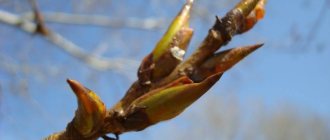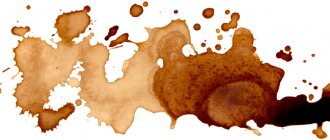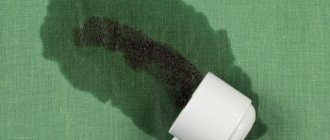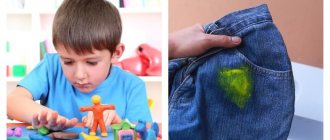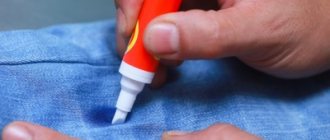If you are a young mother, every spring a certain problem awaits you. Imagine: you pick up your child from kindergarten, and the jeans you just bought, your favorite jacket and boots bought from an online clothing store, all have traces of a sticky yellow substance. A natural question arises: what is it and how to deal with it?
Surely the clothes were damaged by linden or poplar with their resin. At the beginning of spring (March or April), when the leaves have not yet blossomed, the buds on the linden trees swell, releasing a yellow substance that adds headaches to motorists and contaminates clothes.
The main difficulties in removing stains
To understand what means can be used to treat stains from linden and poplar buds, you need to understand a little deeper what the resin of these trees represents.
In composition, it is a combination of several polymers that can firmly and very quickly eat into any surface. Absorption into the fabric occurs instantly, so many housewives know that dealing with traces of resin is a difficult and sometimes almost hopeless process. After all, all washing powders and bleaches are created to remove completely different contaminants, but they are not effective when working with tree resin. Prolonged soaking, frequent washing, and the use of physical force will not help to wash poplar buds.
Substances that can remove traces of poplar and linden buds are solvents that contain acetone and more aggressive components. They enter into a chemical reaction with the resin and destroy traces of its presence on clothing. Substances that can quickly remove traces of linden and poplar buds include:
- Hydrobromic acid is an effective but extremely toxic agent that can be harmful to health. It is not used for household needs, even if there is a need to wash the linden;
- Nitric acid concentrate is an equally hazardous substance that is not suitable for cleaning clothes at home;
- Acetone is a solvent that can be used to remove linden or poplar buds from clothes, but you must follow the rules of use;
- Sodium hypochlorite is a chlorine bleach that is often used to remove a variety of stains on white fabrics, including linden and poplar buds.
Among the products that can certainly cope with the task, there are only two that, although with extreme caution, can still be used to clean clothes stained with linden. Do not forget that they can only help with minor stains and only on the condition that the fabric that will be processed is of high quality and durable.
Cleaning Methods
In most cases, various means are used to remove these types of stains.
Every girl at least once in her life scrubbed paint stains with acetone, which is quite suitable for this type of stain. That is, it should be a liquid that you use to remove polish from nail plates, or rather a product that contains as much acetone as possible. Some people mistakenly assume that gentler products will also help, but in fact, only acetone and solvents can deal with stains of poplar resin secreted by the kidneys.
Using this product to remove stains is very simple; to do this, you need to blot a cotton pad with acetone and move in a circular motion from the edges to the central part of the stain. In order not to stain the item even more while the mark is being removed, the cotton wool will need to be changed as soon as it gets dirty.
Once the woman has removed the stain, she will need to wash the item, since the unpleasant odor may remain for a long time.
Other cleaning methods:
All stain removers designed to remove poplar buds from clothing must be used exclusively in accordance with the instructions. That is, even if you have not washed off the stain, you should not use a larger amount, as this can harm any fabric, especially those places that were not stained by linden. To ensure that the stains are removed, you may need to repeat the procedure several times.
After the housewife has dealt with such contamination once, she will forever remember how to remove stains and what is required for this. In addition, this question will always be relevant in the spring, when people often walk under poplars and other trees.
How to wash linden and poplar on clothes using folk remedies
Since it is extremely difficult to remove a stain from a poplar bud, and the use of aggressive agents is dangerous, it is worth starting with the advice that has been proven over the years. Among the popular methods, the following options can be distinguished:
- Using acetone-based nail polish remover (if it is replaced by other components, then using the liquid is useless). It’s easy to wash poplar buds with nail polish remover: you just need to treat the stain with a cotton pad. If after the procedure there are stains on the fabric, then it is necessary to rinse the item with vinegar;
- Heat treatment of things. To remove the resin, it must be heated. To do this, the product is covered on both sides with paper or cloth (preferably white) and carefully ironed with an iron, under which it is necessary to place a sheet of paper so that the iron platform does not stick to the resin, which will be absorbed into the bed fabric;
- Among the solvents, one can note a product that is very safe for fabric and human health - ethyl alcohol. It needs to be applied to a cotton pad and treated the problem area. This method will help remove Velcro from poplar on large items that are difficult to remove;
- Kerosene or gasoline. These substances should only be used in desperate situations, as they can harm clothing and leave behind a very persistent and unpleasant odor. A cotton swab should be moistened in liquid, treated the surface, washed in a basin by hand, and then immersed in the washing machine (this is necessary so that the smell of fuel is not absorbed into the drum);
- Gasoline can also be used on delicate fabrics, but it must be mixed with egg yolk. To do this, you need to take 1 tablespoon of fuel, 1 yolk and mix the ingredients thoroughly. Apply the mixture to the stain from linden or poplar buds, leave for 5 hours, wash in the usual way;
- In addition, you can use turpentine, which is mixed in equal proportions with egg yolk, applied to the mark of linden buds and, after 5 hours of infusion, washed off with powder. If the stain cannot be removed the first time, the procedure can be repeated;
- Since ancient times, turpentine has been mixed with tooth powder. This product helps eliminate various contaminants, even those as persistent as resin from linden buds. In a bowl, combine equal parts of powder and flammable material (you can purchase it at a hardware store), stir thoroughly to obtain a mass similar to sour cream. Apply the product to the contaminated area and leave for several hours. Then wash the product and dry it in fresh air to eliminate the persistent smell of turpentine;
- This complex mixture can also remove linden stains from clothes: a tablespoon of acetone, the same amount of vinegar, ½ spoon of glycerin, 2 teaspoons of soda. Mix all the ingredients, apply to the stain and wait until the linden trace is completely dissolved. If there is no reaction after 2 hours, you can add a little more acetone to the mixture and reapply it to the problem area.
We use solvents
These agents break the bonds between resin molecules, allowing it to be removed from the fabric. But you need to use them carefully so as not to damage the material itself or its coloring.
Acetone
You can use nail polish remover instead. Just make sure that it contains acetone itself and does not contain additional oils or aromatic additives that may interfere with the dissolution of stains.
Moisten a cotton pad with the product and gently rub it onto the contaminated areas of the fabric. After finishing the treatment, be sure to ventilate the item well to get rid of the persistent odor.
Turpentine
This method is great for removing stains from dark clothes or denim. Stir half the egg yolk and half a teaspoon of turpentine in a bowl until smooth. Then spread the finished product onto the contaminated areas and leave it like that for several hours. After completing the procedure, wash the fabric with laundry soap or stain remover.
Alcohol
The product will help deal with stains on light-colored fabrics. Just wet the problem areas with alcohol, and after a few minutes wash the item with laundry soap. If necessary, repeat the procedure again to achieve better results.
Petrol
Soak a cotton pad with a small amount of this substance and gently rub it onto the fabric. After this, wash the item by hand with double the amount of powder added.
Do not be alarmed by the sharp, pungent odor; it will disappear after the second wash of the material.
White Spirit
In its pure form, this product is only suitable for treating rough fabrics or old clothes. Lightly moisten a cotton swab with it and quickly rub it onto the contaminated surface, being careful not to touch the material.
If you need to clean delicate fabric, mix the product in equal proportions with egg yolk and apply to the problem area for 5 hours, and then wash as usual.
How to wash linden and poplar from clothes using household chemicals
To wash off linden on clothes, you will have to put in a lot of effort. If folk remedies turn out to be ineffective or there is no desire to experiment, you can also use household chemicals.
- Chlorine-containing bleaches - they are used only on white things that are resistant to aggressive substances. The most popular and widespread remedy is ordinary whiteness. It is best to try to wash linden or poplar buds with gel: it does not spread over the rest of the surface and has a targeted effect.
- Laundry soap . You can try to scrub poplar and linden from clothes with this universal soap, which contains a large amount of alkali. Rub the stain with soap and leave for several hours. Wash in a machine with the addition of baking soda, which can be poured into the powder compartment.
- Domestos or similar products in liquid form. You can use the product only on light-colored clothing, apply it to a trace of linden or poplar and leave for a few minutes.
- Powders for cleaning various contaminants that are used by housewives in everyday life. It is worth giving preference to universal products that can remove fatty deposits, rust, and limescale. Sprinkle the powder onto the dampened poplar stain and rub a little, being careful not to spoil the fabric. Wash after 30 minutes.
Liquid bleach
First, turn the material inside out and apply the product to the contaminated areas. After finishing the treatment, you should wash the item using laundry soap and rinse.
It is best to use bleach on white or light-colored fabric, otherwise there is a risk of washing off the paint from the material along with the stain. For colored clothes, special stain remover sprays are suitable.
If you are not sure about the safety of the product, check its performance on a small, inconspicuous area of the material. Be sure to use gloves to avoid damaging the skin on your hands during the process.
Instead of bleach, you can use Domestos or another similar product.
Even more useful tips around the house on our Yandex channel. Zen. Subscribe!
Useful tips
To effectively remove stains from poplar, you need to take into account a number of general recommendations:
- It is easier to remove any stain if it is fresh. Therefore, the resin should be removed as quickly as possible: this way it will not have time to be firmly absorbed into the fabric. If poplar buds get on your clothes during a walk, you can take emergency measures by applying a little eau de toilette or perfume to the stain;
- If, after using solvents, an unpleasant odor remains on your clothes, you should hang the item in fresh air or wash it additionally;
- If stains from linden or poplar buds are old, then only an aggressive agent can remove traces of buds. Before using it, you should take care of your own safety: work should be carried out with gloves, with access to fresh air.
How to remove linden resin from clothes
If you are a young mother, every spring a certain problem awaits you. Imagine: you pick up your child from kindergarten, and the jeans you just bought, your favorite jacket and boots bought from an online clothing store, all have traces of a sticky yellow substance. A natural question arises: what is it and how to deal with it?
Surely the clothes were damaged by linden or poplar with their resin. At the beginning of spring (March or April), when the leaves have not yet blossomed, the buds on the linden trees swell, releasing a yellow substance that adds headaches to motorists and contaminates clothes.
Why are such contaminants so persistent?
If there are a lot of linden trees in the yard, then the buds will be everywhere - on the sidewalks and roads, benches, car roofs. From there, the sticky resin easily gets onto clothes and shoes. This applies to a greater extent to children who play outside.
When such dirt gets on jackets, raincoats and other outerwear, it leaves persistent, difficult-to-remove stains. Thus, a logical question arises: how to remove linden or similar stains from clothes, especially at home?
It is problematic to remove them from a car that also suffers from linden and poplar buds, but it is possible: buy a special product from an auto chemical shop, and the problem will be solved. You will have to tinker with things: sometimes the dirt is so difficult that the only thought that arises is: you have to throw it away.
Soaking and regular washing will not remove a greasy stain, because washing powders usually deal with dirty stains, traces of grease and food. Linden resin is a chemical compound of polymers. It does not dissolve in plain water or alkali solutions.
Even solutions of some acids do not have a positive effect. The substance strongly eats into the material, so cleaning it is problematic.
Let's turn to chemistry
To understand how to wash linden, let’s refresh our school knowledge. If you need to remove linden stains, you need to find a product that reacts with the resin. Among the solvents of resinous substances, at least four substances can be noted.
The best remedy is nitric acid, but for obvious reasons it is not suitable, because it causes significant harm to health.
Hydrobromic acid is not suitable for a similar reason. The third option - acetone - looks more attractive. Finally, you can use sodium hypochlorite - a household bleach with a strong bleach smell.
Of these options, only two are suitable: acetone and bleach. But be careful, as they can cause damage to your clothes. Practice shows that it all depends on the amount of pollutants and the type of soiled fabric.
If the material is natural and not brightly colored, there is a much greater chance of cleaning the item of clothing. Try to remove the lime stain using one of the methods - perhaps it will be effective.
How to wash poplar buds? - Theoretical knowledge
In order to understand how to wash poplar buds from clothes, you need to remember a little school chemistry course. It is necessary to choose a product that dissolves the tarry base of the stain. Among all the solvents of the resinous base, several preparations can be distinguished:
Nitric acid
Nitric acid is the most effective way to remove linden from clothes. But due to its properties harmful to the human body, it should not be used for these purposes.
Hydrobromic acid
This tool can also quickly and easily solve the problem. But for the same reason as nitric acid, it is not used in this case.
Acetone
This product will help remove unattractive stains from clothes without harming human health. Of course, the last condition is only possible if the safety rules when working with acetone are observed.
Bleach
Chlorine-containing bleach is available to almost every housewife. Its big disadvantage is the very strong smell. Therefore, such a product should be used with extreme caution to remove linden from clothes.
Conclusion
Of all the options proposed above, only two will not cause much harm to human health: acetone and bleach. Apply one of the stain removers to your clothing. Perhaps it will be effective.
Important! Clothing made from natural fabrics in calm shades has a better chance of getting rid of yellow poplar marks.
Acetone or nail polish remover
After reading forums where similar cases are discussed, we came across a wonderful recipe. You need to take the usual liquid that is used to remove manicures, blot a cotton pad and remove the resin.
The only condition: the liquid must contain acetone. In this case, it will be useful. This is an important note, because now various additives and oils are added to similar products to cause less damage to the nails. In some there is no acetone at all.
A simple rule: carefully read the composition before starting to process the product. What is needed is the “regular” version, which contains a maximum of acetone. Pure acetone can be purchased at a hardware store that sells repair products, paints and varnishes.
Acetone is good for processing; it will even save shoes or a stroller if the need arises. The only negative: wardrobe items will have a specific smell for some time. Good ventilation will help get rid of the smell.
Methods
Going through the forum sections with the question of how to remove yellow stains from poplar, you can come across a recommendation: “Take regular nail polish liquid, wet a cotton swab with it and gradually remove the stains.” As we know, nail polish remover is acetone. And he, according to the table, can remove resin. Therefore, this method suits us.
Please note that recently they have begun to add all sorts of oils and additives to nail polish remover to make nails less likely to deteriorate. There are such liquids without acetone. The word “ordinary liquid” is key here, implying that the composition contains only acetone. Therefore, if you want to effectively clean your clothes, look at what your product consists of before use.
You can also buy acetone where they sell paints and varnishes for repairs. The product really pays off, since it can even be used to clean shoes and strollers if necessary. True, things will have a specific smell for some time, so they need to be ventilated.
If your clothes were perfectly white, you can use liquid bleach. As a last resort, try Domestos or something like that, just be careful not to dissolve the fabric too.
Other healthy recipes
You can try cleaning white clothes with liquid bleach. In a hopeless situation, Domestos or its equivalent will do. Proceed with extreme caution, otherwise the fabric will simply dissolve.
Initially, turn the item inside out and test the effect on an inconspicuous area. If the last recipe does not work, try treating the stained area with gasoline and then washing it with soap.
As an almost win-win option, housewives recommend an anti-stain spray produced by Amway. Shake the can, apply a little spray to the fabric, hold for a certain time, wash with laundry soap.
You can treat lime stains with alcohol and then wash them off. The following recipe will help: 0.5 tsp. turpentine and the same amount of egg yolk (the first component can be replaced with white spirit). Treat the stain with the mixture, wait five hours and wash. Folk recipe: turpentine for dark clothes and soap alcohol for light ones.
Liquid bleach
First, turn the material inside out and apply the product to the contaminated areas. After finishing the treatment, you should wash the item using laundry soap and rinse.
It is best to use bleach on white or light-colored fabric, otherwise there is a risk of washing off the paint from the material along with the stain. For colored clothes, special stain remover sprays are suitable.
If you are not sure about the safety of the product, check its performance on a small, inconspicuous area of the material. Be sure to use gloves to avoid damaging the skin on your hands during the process.
Instead of bleach, you can use Domestos or another similar product.
Cause of problem spots
In the past, many residents planted large numbers of linden and poplar trees in their yards.
This was done for the purpose of landscaping the yard, so that in hot summer weather you could enjoy the shade and coolness under a tree in your yard. No one expected that over time these trees would create so much inconvenience. With the arrival of spring, almost all the benches, sidewalks, curbs, windows, and cars acquired strange yellow spots in which the yard children were quickly busy.
Once on the fabric, the juice of linden and poplar buds strongly ate into it due to its sticky structure, which made all attempts to clean the fabric from these stains almost ineffective. For many housewives, this is a serious problem, because not everyone knows how to wash poplar buds from clothes.
Car enthusiasts are luckier, because many car shops, car washes and showrooms sell products that are applied to the body in order to maximally prevent the “sticking” of tree buds; when washing, they are easily removed from the body.
Traces that have become embedded in the fabric or varnish of a car body are very difficult and sometimes almost impossible to remove. Washing and powder soaking the clothes will not help; simply rubbing with a rag will not clean the body.
How to remove linden from clothes
There are many options for how to remove linden stains from clothes, but not all of them can completely remove the stain. Several of the most effective options for removing poplar buds from clothes:
- Household chemicals. The cleanser should contain acetone, the more the better. It is necessary to apply the product to a cotton pad, after which the dirt should be removed using circular movements from the edge to the center. It is better to use several cotton pads. After treatment with the cleaning agent, clothes should be washed in a regular machine. Thanks to this method, even the white color of clothes will be saved.
- Heat. This method is based on increasing the temperature of the contaminated site. The resin will heat up and can be absorbed into another cloth or paper towel. After the stain is heated, you need to bring a napkin or cloth to the stained area and remove it with light pressure. This cleaning method can take up to half an hour.
- Ethanol. A substance that is found in every apartment is ethyl alcohol. The most popular solvent. It is necessary to moisten the cotton wool, then wipe the area with linden juice until the dirt is removed. Alcohol can only remove small stains.
- Kerosene, turpentine, gasoline. Undiluted, they are too concentrated, so they can only be used on old clothes. The substance must be applied to a cotton swab and gently soaked to remove dirt from the fabric. It is important not to touch the fabric too much, but to act on the dirt itself. To use the solvent on delicate fabric, you need to mix it with egg yolk in a 1:1 ratio, then process it, leaving it for 6 hours. After 6 hours, it will be enough to wash the item in the washing machine.
- Laundry soap. It will be effective in the fight against small stains that have not yet become embedded in the fabric. The area should be rubbed and left to sit for 30 minutes, after which the item should be washed.
Removing linden stains from the soles of shoes is a little easier than removing them from fabric. To do this, you need to moisten a cotton wool with alcohol or acetone and wipe the stained area on the sole. Then the shoes can be wiped with water and placed on the balcony to air out. The sole will be like new.
Professional products
You can always use special stain removers. They contain components that penetrate deep into the fibers and clean the product in a few minutes. However, in this case, such compositions cannot help every time, although they effectively cope with old and difficult stains and remove stains of grease, food and drinks.
You can use standard laundry soap. It contains an increased number of acids, due to which it can remove fresh yellow and sticky stains. Lather the contaminated area, leave for half an hour and rinse, finally wash in the washing machine or by hand with a suitable powder or gel.
Instead of laundry soap, you can use special Antipyatin soap. This is an inexpensive, safe and accessible product that easily removes various types of contaminants. It does not cause allergies and is even suitable for washing children's clothes. For the best way to wash children's clothes, see the link https://vsepodomu. ru/stirka/luchshee-sredstvo-dlya-detskogo-beliya/.
How to remove linden from clothes at home
During the period of active flowering of trees, it is very easy to obtain difficult-to-remove contaminants. These include linden stains. It has a yellow color and a characteristic odor. Linden is a polymer compound containing plant resins. Resins do not interact with water; they are insoluble in an aqueous environment.
The compounds do not react with most acids and alkalis. The only acids with which the resin reacts are nitric and hydrobromic. But in ordinary life you are unlikely to encounter them, especially since acids are toxic to both humans and tissue. Acetone and a number of similar organic compounds have properties that neutralize the resinous substance and absorb it from the site of contamination. Chlorine, which is part of concentrated chlorine-containing bleaches, has the same effect.
When it gets on clothing or skin, linden eats deeply into the structure of the fabric or skin and leaves a sticky residue. If you try to rub the stained area, the lime stain increases in size and eats into the fabric even more. If a linden stain was noticed immediately, you can try to remove it using laundry soap and a stiff brush. Wash the surface with a soapy solution and rub vigorously with a brush; the stain will begin to fade and then go away completely. This will help to remove a small lesion.
You need to start cleaning your clothes from linden immediately. The resin is instantly absorbed and remains in the fabric forever, there is a high risk of ruining the clothes.
Starch paste
Let's look at how to remove old tree resin from clothes, and in this case, starch paste will help. It contains potato starch (1 small spoon), ammonia (4 drops), turpentine (4 drops). Apply the mixture to the resin stain and, after drying, rub it with a brush. If a trace remains, the procedure must be repeated. At the end the item needs to be washed.
Another paste option is white clay (1 small spoon), potato starch (1 small spoon), ammonia (1 drop) and turpentine. The dry ingredients are diluted with turpentine to a paste, then ammonia is dripped in. The mixture is used in the same way.
To increase the cleaning efficiency, it is recommended to pre-lubricate old pine resin with fat - vegetable or butter, or Vaseline. After it softens, it should be scraped off with a metal object, and then treat the stain with starch paste.
If laundry soap does not help in cleaning, you can resort to the following methods:
Acetone, nail polish remover
Since resin is a complex chain of polymer compounds, it can be destroyed using organic solvents.
But there is a small chance of ruining the fabric on the clothes, so it is better to first try to drop a little liquid or acetone on the wrong side in a less noticeable area and see what happens to the fabric and color. If the color and structure of the fabric remain the same and have not changed, then you can begin to remove the lime stain. If you have nail polish remover at home, it is better to use that first because it contains less acetone or its derivatives and is less toxic. However, in terms of effectiveness, nail polish remover is inferior to acetone. A small amount of liquid or acetone is applied to a cotton pad, and then to the contaminated surface, rubbed in and left for 3-4 minutes. Assess the stain. If it has decreased in diameter or lost its intense color, then continue cleaning using a new cotton pad. Apply solvent to the problem area up to 3-4 times; it is not recommended anymore, since the tissue structure becomes thinner and can be damaged. Then, after cleaning, the product is washed to remove odors and stains.
Stain removers, household chemicals
These products have a targeted effect on the destruction of linden resin and help remove it from the surface of clothing. For white items, you can try removing the stain with bleach, and for colored items, use a stain remover. It will be better if the product has a gel consistency. The gel penetrates deeply into the fibers of the fabric and removes resinous compounds. Pour a little gel stain remover or other product onto the stained area and leave it for 5-10 minutes. The product is then machine washed as usual.
Ethyl and ammonia
Since these compounds are of organic origin, they quickly destroy the polymer bond of the resin, thereby removing contamination. Alcohol is applied using a napkin soaked in it and applied several times to the area of contamination. After a couple of actions, the stain will noticeably fade and soon disappear completely.
Thermal methods
When heated, linden resin becomes plastic and soft, and at low temperatures, on the contrary, it becomes hard. This property can be used for effective cleaning. Heat the iron and place a clean cloth over the stained area. Pass a hot iron over the contaminated surface. The linden marks transfer to the napkin. The process is repeated several times until the contamination completely disappears. There is a high probability that this method will help clean your clothes. If the item cannot be ironed, for example, due to the fine texture of the fabric, then it is frozen in the freezer or rubbed with an ice cube. At the same time, the resin begins to harden. Then use a scraper or a stiff brush to remove the dried stain.
What to remember
- The fresher the stain, the easier it is to remove.
- Be sure to test the product on an inconspicuous area of fabric.
- Take precautions.
- Do not use solvents on delicate or acetate materials.
Resin is an amorphous substance of plant or synthetic origin, which under normal conditions is in a solid state, but melts when heated. You can get dirty in it in a forest or city park, on an asphalt road, or while repairing electrical wiring using rosin. Due to their complex structure, resin stains are difficult to remove. But don’t worry, there are effective methods to combat them. Let's figure out how to remove resin from clothes at home.
Before you wash the resin from your clothes, you need to perform several manipulations. First, scrape off the main layer of the substance using a knife (dull side) or spoon. Be careful not to stretch the fabric or rub resin contamination into the fibers.
After preliminary cleaning, the item with the stain must be wrapped in plastic and placed in the freezer for 60-90 minutes. The resin will harden and become brittle. If you crush it, it will crumble into small pieces. Residues can be removed with a brush. What to do with a large item that cannot be put in the freezer? Rub the tar stain with an ice cube several times to harden it.
In most cases, scraping off the resin and placing it in the freezer will still leave a mark on the fabric. Let's figure out how to remove tar stains from clothes using improvised means. But first, here are some general tips:
- Use a dry brush to remove dirt and dust from the fabric to prevent streaks and new stains from forming;
- if the product has a lining, then it must be carefully ripped open and only the layer contaminated with resin must be processed;
- the material where the trace of resin is located should be placed on a hard surface, the best option is a board wrapped in an old cotton napkin;
- A clean cloth around the resin needs to be wetted and also sprinkled with starch (talcum powder) so that the stain does not “spread” when cleaning.
Important: Exposure to cold is unacceptable if the item is made of thin, delicate fabric. Creases during further mechanical cleaning can lead to damage to the fibers.
Total information
Linden resin is a special chemical compound consisting of polymers that eat into any material. So how to wash poplar and what to use for this? It is pointless to remove stains with means such as powder, since they are aimed only at removing dirt or greasy stains, and poplar resin does not lend itself to them.
Housewives think that if she once washed with powder or soap, then next time these cleansers will also help. But in fact, only fresh contamination can be eliminated using this method. Others mistakenly assume that soaking will help to wash poplar buds, but the resin trace cannot be dissolved in ordinary water or soap solution. How to remove stubborn stains?
To cope with poplar stains, you will need acetone or other fairly aggressive agents.
In order to know for sure how to remove linden from clothes next time, you need to follow certain tips:
- if we notice poplar resin on clothes, then remove it as soon as possible, since it very quickly seeps into the structure of any material;
- To ensure that soiled clothing does not deteriorate, but everything is washed, it is necessary to check the effect of the aggressive agent in a limited area. That is, try to clean off the trace of resin from one edge. After the aggressive substance has been applied, you should wait about half an hour, since during this time all possible destructive effects should appear. If everything is in order with the clothes and traces of poplar resin have been eliminated, then you can safely begin cleaning.
Since a solvent is used to remove this kind of stain, after washing clothes or other items, they will smell extremely unpleasant; this problem can be solved by airing.
Heat treatment
When figuring out how to remove pine resin from clothes, you should pay attention to the simplest method - heat treatment with an iron or hair dryer.
Algorithm of actions:
- Place a clean rag or porous paper under the resin stain and on it.
- Iron the top with a hot iron.
- Change the rags that will absorb the melted resin as they become dirty.
- Soak the product in warm water, rub the remaining stain with laundry soap, and wash after 15-20 minutes.
If the resin ends up on something made of thick fabric or leather, it is better to blow it off with hot air using a hairdryer. Melted “tree sap” should be removed with a napkin.
By means of heat treatment, small fresh stains from the resin can be removed. In most cases, old and large stains leave a trace. Let's find out how to remove resin from clothes if an iron or hair dryer did not help to completely clean the item.
